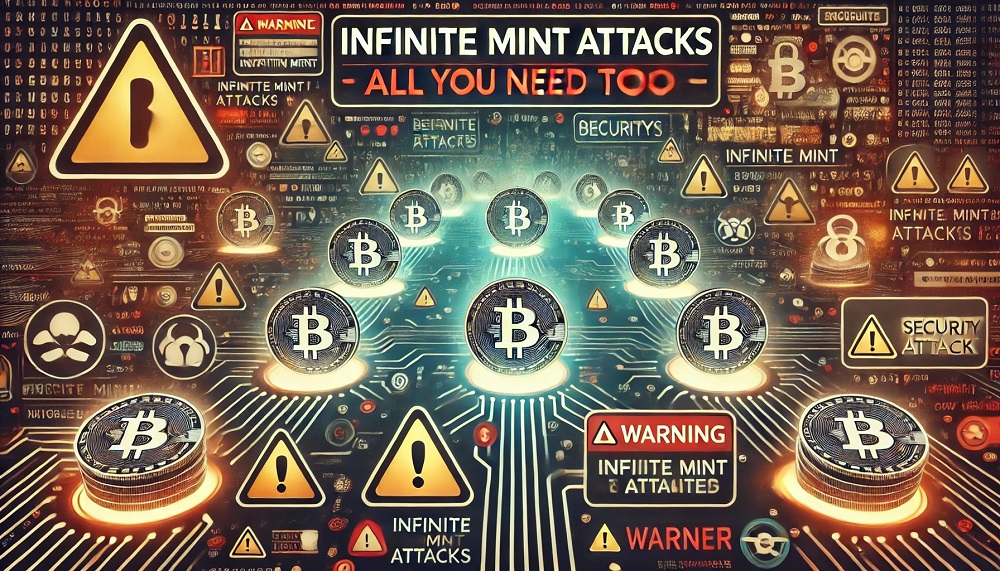The decentralized finance (DeFi) ecosystem has continued to bear the brunt of systemic exploits in the digital asset space, especially the loss of integrity of these affected platforms when users lose their assets. Infinite Mint Attacks have become one of the ways hackers invade the DeFi space, draining funds from users’ wallets and raising concerns about the safety of investors’ portfolios.
Understanding the Infinite Mint Attacks in DeFi
Infinite Mint attacks pose a serious threat to the security and stability of decentralized finance ecosystems. These attacks occur when an attacker exploits flaws in a smart contract’s code to create more tokens than the authorized supply limit.
The consequences include significant financial losses and a drop in the token’s value. This guide examines the mechanics of endless mint assaults, their impact, prominent examples, and the precautions required to prevent such threats.
The Mechanism of Infinite Mint Attacks
Infinite mint attacks generally target smart contracts that provide token-minting functionality. These attacks exploit logical defects in the contract’s code, allowing attackers to generate an infinite number of tokens.
Furthermore, the process typically occurs in three stages:
Vulnerability Identification: The attacker initially finds flaws in the contract’s code, which are usually connected to input validation or access control methods. These flaws allow the attacker to circumvent the standard authorization methods that limit token minting.
Exploitation: Once a vulnerability is identified, the attacker creates a rogue transaction to exploit it. This includes changing contract parameters, executing certain functions, or taking advantage of unexpected relationships between different parts of the code. As a result, additional tokens are minted without authorization.
Unlimited minting and token dumping: With the vulnerability exploited, the attacker can continue to create new tokens. These newly minted tokens are frequently dumped onto the market and swapped for other cryptocurrencies or stablecoins. Thus, this quick flood of tokens causes inflation, which devalues the token and results in large financial losses for stakeholders.
Impact of Infinite Mint Attacks
Mint attacks have other effects beyond affecting the token’s value.
Ecosystem Disruption
This token devaluation impacts decentralized applications (DApps), exchanges, and other token-dependent services, causing larger ecosystem instability.
Case Study: Paid Network Attack
A notable example is the attack on the Paid Network, in which a weakness in its smart contract was exploited to manufacture and burn tokens, leading to a $180 million loss and an 85% decline in the network’s token value. Before the hack was discovered, the attacker converted more than 2.5 million PAID tokens to Ether (ETH). The network later refunded subscribers, refuting rumors about an internal “rug pull.”
Comparison between Infinite Mint and Reentrancy Attacks
Reentrancy attacks target the withdrawal mechanisms of smart contracts, whereas infinite mint attacks create an endless quantity of tokens. A reentrancy attack occurs when an attacker repeatedly invokes the withdraw function before the contract’s balance is updated, resulting in a continual drain of cash.
Both types of attacks take advantage of flaws in smart contract programming, although their techniques and outcomes differ. However, understanding these variations is critical for creating effective security solutions.
Preventing Infinite Mint Attacks
Preventing infinite mint attacks requires a strategy that prioritizes security throughout the crypto development and deployment process.
Code Audits and Security Reviews
Independent security specialists must regularly and thoroughly audit smart contract codes. These audits should detect and repair any potential vulnerabilities that could allow for unlimited minting. Moreover, continuous security evaluations help to ensure that the code stays resistant to evolving attacks.
Implementing Strong Access Controls
Only authorized parties should have minting capabilities. Implementing strong access controls and multi-signature wallets can improve security by making it harder for attackers to get unauthorized access to minting functions.
Real-time Monitoring and Response
Real-time monitoring tools are crucial for discovering anomalous transaction patterns or abrupt surges in token production. Prompt identification enables quick responses to possible threats, reducing damage and ensuring ecosystem stability.
Conclusion
Infinite mint attacks pose a significant threat to the DeFi ecosystem, resulting in financial losses and weakening trust in blockchain networks. Understanding how these attacks work and implementing strong security measures are critical steps toward preventing them and guaranteeing the stability and integrity of the cryptocurrency ecosystem, including DeFi networks.
